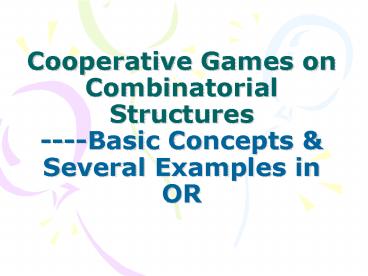Cooperative Games on Combinatorial Structures Basic Concepts - PowerPoint PPT Presentation
1 / 25
Title:
Cooperative Games on Combinatorial Structures Basic Concepts
Description:
Cooperative Games on Combinatorial Structures ----Basic Concepts ... Pre-imputation set: Imputation set: Polyhedron associated to a game: 1. Basic Concepts(4/9) ... – PowerPoint PPT presentation
Number of Views:124
Avg rating:3.0/5.0
Title: Cooperative Games on Combinatorial Structures Basic Concepts
1
Cooperative Games on Combinatorial
Structures----Basic Concepts Several Examples
in OR
2
Outline of this lecture
- 1. Basic Concepts
- 2. Examples in OR
- 3. Problems Methodology
- 4. Some of my own ideas
3
Basic Concepts(1/9)
- Def. 1 cooperative games vs. noncooperative games
4
1. Basic Concepts(2/9)
- Def. 2 Transferable utility game
- Players elements of N1,2,, n
- Coalitions subsets of N
- Worth the value of S, v(S), is called the worth
of S - Characteristic function V
- Profit games cost games
5
1. Basic Concepts(3/9)
- Subgame
- Efficient
- Pre-imputation set
- Imputation set
- Polyhedron associated to a game
6
1. Basic Concepts(4/9)
- Def. 3 core
- Balanced games
- Totally balanced games
- Dual game
- Pro. 1 (N,v) is a profit game and (N,v) is a
cost game, then
7
1. Basic Concepts(5/9)
- Excess of S at x e(S,x)v(S)-x(S)
- Stronge-core
- Least core
8
1. Basic Concepts(6/9)
- Multiplicative core
- Def. 4 The nucleolus of Y is the set of
pre-imputations in Y that minimize T in the
lexicographic ordering
9
1. Basic Concepts(7/9)
- Shapley value
- Banzhaf value
10
1. Basic Concepts(8/9)
- Unanimity game
- Every game is a unique linear combination of
unanimity games
11
1. Basic Concepts(9/9)
- Tijs value
- Upper value
- Utopia payoff
- Lower value
- Def. 5 quasi-balanced
- (QB1)
- (QB2)
12
2. Examples
- 1. Assignment and matching games (Shapley and
Shubik,1972) - 2. Min-cost spanning tree games (Granot and
Huberman,1981)
13
2. Examples
- 3. Linear production games (Owen,1975)
- 4. Tax games (Tijs and Driessen,1986)
14
2. Examples
- 5. Bin packing games (Faigle and Kern, 1993)
- 6. Simple flow games (Kalai and
Zemel, 1982 Reijnierse,Maschler,Potters and
Tijs,1996) - 7. Permutation games
- (Tijs, Parthasarathy,Potters and Prasad,1984)
15
2. Examples
- 8. Travelling salesman games (Potters, Curiel and
Tijs, 1992) - 9. Delivery games (Hamers, 1995)
- 10. Sequencing games (Curiel,Pederzoli and
Tijs,1989) - 11. Restricted games (Myerson, 1977 Owen, 1986)
16
2. Examples
17
3. Problems Methodology
- Problems
- 1. Is a cooperative game balanced\totally
balanced? - 1.1 cooperative games determined by combinatorial
optimization problems - 1.2 restricted games
- 2. How to allocate the profit among the grand
coalition? - 2.1 axiomatic approach efficiency, linearity,
dummy axiom, chain axiom - 2.2 computing of Shapley values
- 3. Complexity analysis
- 3.1 testing nonemptiness
- 3.2 checking membership
- 3.3 finding a core member
18
3. Problems Methodology
- Methodology
- 1. to characterize the structure
- Graph theory
- Algebra poset, lattice, closure space, convex
geometry, matroid, greedoid, antimatroid,
partition system, unionstable system
19
3. Problems Methodology
- 2. to characterize and analyze v
- Optimization theory dual theory, integer and
combinatorial optimization - Discrete convex analysis supermodular functions,
subdifferentials, indirect functions, least
increment functions - Basic ideas (relaxing, transforming, extending)
- Bicooperative games, Fenchel conjugation, Lovasz
extension - 3. to analyze the complexity
- Computational complexity theory
20
4. Some of my own ideas
- 1. A more realistic definition of v
- We call a situation, the worth of a
coalition is situation depended. - More realistic (at least in certain situations)
- It embodies more of the essence of game theory.
21
4. Some of my own ideas
- 2. Equilibrium problems
- balancedness a kind of Nash Equilibrium
- Allocation rule before equilibrium
- Under this assumption, cooperative games can be
converted to non-cooperative ones. Every one
makes his decision to prefer a situation to
maximize his profit.
22
4. Some of my own ideas
- 3. New allocation rules
- To allocate profits among players according to
their powers - To allocate according to indispensability
23
4. Some of my own ideas
- 4. dynamic approaches to distribute profits
24
4. Some of my own ideas
- 5. Stability of the coalition
- The bigger the coalition is, the less stable it
is. - 6. Asymmetric information
- 7.Cost of forming the coalition
25
- THANKS!































